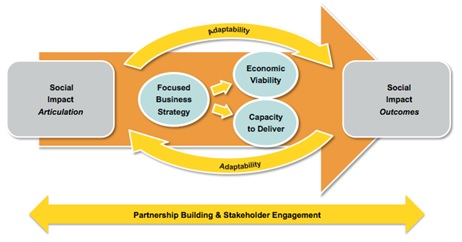Sustainability Framework
Using a framework developed by Community Wealth Partners (CWP) helped define the six key drivers of sustainability:

- Social Impact: The results of efforts taken that solve or positively advance social issues by producing a positive change in attitude, behavior, or condition for the target constituency.
- Partnership Building and Stakeholder Engagement: The ongoing cultivation and engagement of a cohort of well-functioning, diverse partners and stakeholders who collaborate and communicate effectively to advance the Alliances’ efforts.
- Adaptability: The discipline of updating or developing products and services in anticipation of or response to changes in beneficiary needs, behaviors, and the operating environment.
- Economic Viability: An Alliance’s financial health; sustainable efforts have a surplus or break-even operating model that will carry the work forward in the long term.
- Focused Business Strategy: The understanding of what must happen to achieve social goals and choices about how to accomplish those goals.
- Capacity to Deliver: The talent, infrastructure, and processes needed to execute the business strategy in order to deliver social impact.
In 2014, eighteen months before RWJF funding ceased, CWP conducted a qualitative, quantitative and financial assessment of the Alliances, including the following:
- Clarity and alignment of organizational goals, mission and strategic planning;
- Governance, leadership, and reporting structure;
- Personnel and staff recruitment, development, level of support and retention;
- Financial management (i.e., cash flow, revenue forecasting, reserve funds), fundraising practices and pricing strategy;
- Operations, work plan development and execution, knowledge management;
- Community engagement, public relations, marketing, positioning and branding;
- Constituent service delivery, competitive landscape, growth plan for market, new partner identification; and,
- Membership needs assessment, ability to retain and attract members, delivering products and value to market and members.
Based on analysis, most of the Alliances’ capability gaps, as well as under-developed opportunities, existed in the area of three sustainability drivers—economic viability, focused business strategy, and capacity to deliver. In general, diversification through earned revenue presented the greatest opportunity for Alliances to sustain impact given that unrestricted revenue provides greater flexibility to execute on strategic goals. However, pursuing earned revenue requires significant organizational capacity, e.g., a sales and service culture, timely access to financial data, willingness to take on calculated risk, start-up funds to cover one-time investments, and ability to absorb any losses in the early years. Assessing existing sources of revenue also highlighted the extent to which Alliances were overly dependent on a particular source of funding.
